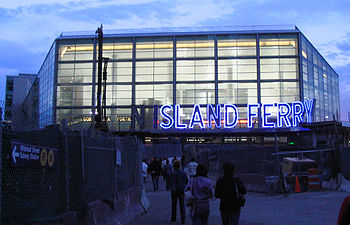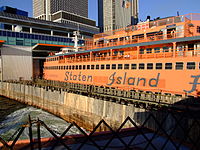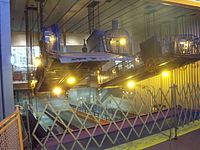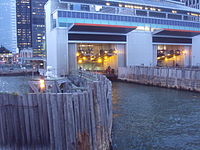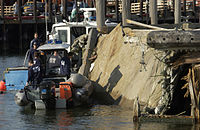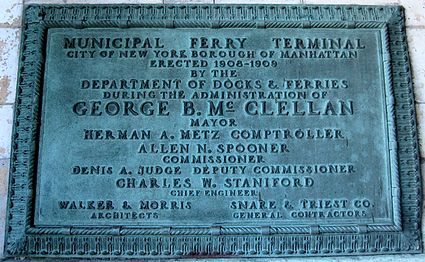- Staten Island Ferry Whitehall Terminal
-
Coordinates: 40°42′09″N 74°00′46″W / 40.702472°N 74.012833°W
 Route of ferry from Whitehall Terminal to Staten Island
Route of ferry from Whitehall Terminal to Staten Island
The Staten Island Ferry Whitehall Terminal (4 South St. and Whitehall St., New York City) is the terminal in the South Ferry area of Lower Manhattan used by the Staten Island Ferry, which connects the two island boroughs of Manhattan and Staten Island. It was completely renovated and rededicated in February 2005 as a major integrated transportation hub for the ferry, buses, subways, taxis, and bicycle lanes.
The ferry travels between the Whitehall Terminal in Manhattan and the St. George Terminal in Staten Island.
Contents
Overview
The completely renovated terminal was designed by New York architect Frederic Schwartz as a major project that included the new two-acre Peter Minuit Plaza in Lower Manhattan.[1] The terminal accommodates over 100,000 tourists and commuters on a daily basis (for transportation open 24 hours a day), and the new design establishes the terminal as a major integrated transportation hub, connecting it with a new South Ferry subway station with access to four subway lines, three bus lines, and taxis.[1] Additionally, through the Terminal and Minuit Plaza, access to bicycle lanes and even other water transport options are also available.[2]
A "gateway to the city," set against the backdrop of Manhattan's greatest buildings on one side and the river on the other, the design was created to imbue the terminal "with a strong sense of civic presence."[1] In his remarks at the terminal's February 7, 2005, dedication, Mayor Michael Bloomberg stated that "You can walk into this spectacular terminal day or night and feel like you're part of the city ... (the terminal) is a continuation of what you feel on the ferry ... in a sense you are suspended over the water."[1]
In addition to the views from within the terminal, rooftop viewing is also part of the new construction, including benches.[3]
Described as "an elegant addition to [the] city's architecture," a 2005 Newsday writer called it a transit hub that is so beautiful that it has become a "destination": with "the panorama of lower Manhattan from the top of the escalators, the vast windows framing the Statue of Liberty, the upstairs deck with views of the harbor -- these are reasons to take shelter here for a little longer than the ferry schedule makes strictly necessary."[4]
Mayor Bloomberg's dedication remarks linked the opening of the Whitehall Terminal to construction at the St. George terminal on the Staten Island side of the ferry line, and to two new state of the art ferries: "Today is a great day for Lower Manhattan and Staten Island.... This beautiful new terminal combined with the new Molinari, the soon to be in service Marchi, and the near completion of the St. George terminal are transforming the Staten Island Ferry experience. Instead of scurrying through dark and dilapidated terminals onto 40-year old boats, passengers will travel through architecturally exceptional airy terminals onto a state-of-the-art fleet."[3]
Multi-use
Designed to employ a state-of-the-art heating and air conditioning system, partially powered by solar panels, the terminal includes a total floor area of 200,000 square feet (19,000 m2), including—in addition to the 19,000-square-foot (1,800 m2) waiting room—6,000 square feet for retailer use, and 10,000 square feet (930 m2) of office space. There is an additional 10,000 square feet (930 m2) of space to support needs linked to ferry operations and ancillary support.[5]
In addition to the many retail shops that now can be found at the terminal, GrowNY, a New York non-profit organization, operates its only indoor farmers market ("Greenmarket") within the terminal.[6]
Whitehall Crossing
As part of the "Percent for Art" initiative, the city's Department of Cultural Affairs[7] purchased and installed sculptured granite benches created by artist Ming Fay, entitled "Whitehall Crossing," in the waiting room. They were crafted to symbolize Indian canoes crossing New York Bay,[5] and include a series of twenty-eight granite benches divided into three serpentine rows, suggesting the carved seats of a "floating, organic form over a water theme terrazzo floor."[8] "As a functional art piece, Whitehall Crossing is almost invisible because it invites viewers to engage in, and thereby become part of, the design while sitting in the benches."[8]
Ming Fay,the Shanghai-born Chinese artist notes that this art he created was "inspired by the Native American's early crossings with dug out canoes." He described his goals for the art as follows:
"In the Staten Island Ferry Terminal, I couldn't see putting an object in the space. I felt a functional statement would be appropriate. It is the imaginary journey before the real journey happens. In the lobby of this modern waiting room there are moments where the space is almost empty with people and then full again. The benches provide those moments of waiting with " invisible artwork" that is part of the space and act of public seating. I feel the experience of the space is about the thought of crossing over to the other side that goes back to the day when people had arrived at this point."[8]
Peter Minuit Plaza
In parallel with the construction of the new terminal, Peter Minuit Plaza was completely reconfigured to provide easy accommodation for pedestrians, buses, and taxes. 42 new trees were included in the redesign plan, along with public space for community activities, covered walkways from the terminal to Whitehall Terminal, a dedicated cab drop-off area and a new bus loop.[5]
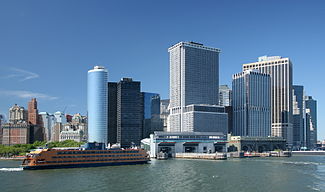 The terminal as seen from New York Harbor in 2008
The terminal as seen from New York Harbor in 2008
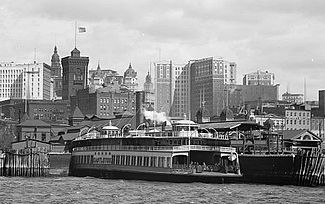 A century earlier, the terminal from the East River c.1905
A century earlier, the terminal from the East River c.1905
In addition to the part the plaza will play in terms of transportation, it will include the "New Amsterdam Plein & Pavilion" (a gift from the Kingdom of the Netherlands), an area to showcase art, design, and horticulture.[9] This area is conceived as an "outdoor living room" where both scheduled and spontaneous activities can take place alongside public markets and a state of the art food and information pavilion.[10] The Plein and Pavilion were designed by Dutch architect Ben van Berkel, and the major grant from the Netherlands which made it possible was given in honor of the celebration of New York's 400th anniversary, and in honor of "the enduring relationship between New York and Holland."[10]
History
The original Whitehall Terminal, called the "Whitehall Street Ferry Terminal,"[11] served Brooklyn, Governors Island, Staten Island, and Weehawken, for passengers who traveled mainly by a system of elevated trains (the "els").[12] However, as subways replaced the els, and cars began to travel through an increasing number of bridges and tunnels such as the Brooklyn-Battery Tunnel, new terminal facilities were built at Whitehall with a primary purpose of serving the Staten Island Ferry. The ferry began operating under municipal authority of the Department of Docks and Ferries on October 25, 1905, approximately seven years after Staten Island officially became part of New York City.[12] The "Municipal Ferry Terminal" was erected 1908-1909, during the administration of Mayor George McClellan, and designed by the architectural firm of Walker and Morris.[13]
Before that, ferry service was provided as early as the 1700s by individuals (and later private companies) with their own boats, but a ferry accident June 14, 1901, involving two ferries from different companies, was a major factor in the decision for the city to take control of ferries as part of the public transportation system.[14]
The older Whitehall Terminal was purely functional, described as a "squat, washed-out green hulk in which function vanquished form," and was once referred to by the American Institute of Architects as the world's most banal portal of joy.[11] When that terminal was gutted in 1991 as a result of a major fire, the city saw the chance to replace it with a building in which it could take pride—but a fourteen-year period of design plan submissions, rejections, and changes, delayed construction again and again—in addition to the basic construction challenges inherent in the rebuilding of the terminal in a way which would cause little or no disruption to ferry service on the water or subway service underneath the construction site.[1]
In 1992, the New York City Economic Development Corporation held an international competition to design a replacement facility, and selected a new design for the terminal produced by Venturi, Scott Brown and Associates. Other entrants included Rafael Vinoly, Aldo Rossi, Polshek Partners and SOM, but the winning design, featuring a barrel vaulted waiting room that was higher than that at Grand Central Station, and what would have been the largest clock in the world, along with a subsequent design featuring a large, electronic facade facing the harbor, were deemed by civic authorities in Staten Island as architecturally unacceptable.
The design ultimately accepted, produced by former Whitehall Architectural Design director Ronald Evitts and Fred Schwartz called for a 19,000-square-foot (1,800 m2) structure to replace the existing building, with a 90-foot (27 m) high entry hall, and a 50-percent larger waiting room with views of New York Harbor, the Statue of Liberty and lower Manhattan.[11] Ultimately, a rooftop waterfront Viewing Deck crowned the building, and included a state-of-the-art photovoltaic array on its canopy, a Percent-for-Art installation called "Slips" by Dennis Adams, and connections on either end to the waterfront esplanade on the east and west sides of Manhattan.
Gallery
See also
- Ferry
- Roll-on/roll-off ferries
References
- Notes
- ^ a b c d e SchwartzArch.com, Ferry Terminal description, retrieved February 21, 2011.
- ^ TheBattery.org, retrieved February 21, 2011.
- ^ a b RenewNYC.com, retrieved February 22, 2011.
- ^ Davidson, Justin, "At last, welcome to Manhattan!", Newsday (April 14, 2005) retrieved February 21, 2011
- ^ a b c NYC.gov website, retrieved February 22, 2011.
- ^ "GreenMarket" website, retrieved February 22, 2011.
- ^ LowerManhattan.info, retrieved February 22, 2011.
- ^ a b c Whitehall Crossing on NYC.gov, retrieved February 25, 2011.
- ^ TheBattery.org:Peter Minuit Plaza, retrieved February 22, 2011.
- ^ a b The Battery Conservancy, retrieved February 22, 2011.
- ^ a b c Chen, David, "Sleeker Design for Staten Island Ferry Terminal is Unveiled", New York Times (March 20, 1997), retrieved February 22, 2011
- ^ a b Staten Island Museum website, retrieved February 22, 2011.
- ^ Photo of 1909 dedication plaque.
- ^ Siferry.com: Staten Island Ferry information website, retrieved February 22, 2011.
External links
New York City History · Neighborhoods · Architecture · Skyscrapers · Tourism · Attractions · Culture · Books · Arts · Parks · Cuisine · Dialect · People · Music · Sports · Media · Economy · Companies · Education · Schools · Government · Mayor · Central Park · Council · Fire · Police · Landmarks · Crime · Elections · Geography · Harbor · Gardens · Flag · Environment · Demographics · Enclaves · Transportation · Hospitals · Lists · Images · Portal
Islands of New York City Barren Island · The Blauzes · Broad Channel Island · Chimney Sweeps · City Island · Coney Island · Ellis Island · Governors Island · Hart Island · High Island · Hoffman Island · Hunter Island · Isle of Meadows · Liberty Island · Long Island · Manhattan · Mill Rock · North Brother Island · Prall's Island · Randall's Island · Rat Island · Rikers Island · Roosevelt Island · Ruffle Bar · Shooters Island · South Brother Island · Staten Island · Swinburne Island · Travers Island · Twin Island · U Thant Island · Wards Island
 Categories:
Categories:- Ferry terminals
- Port of New York and New Jersey
- Staten Island Ferry
- Transit centers
- Transportation in New York City
- Visitor attractions in New York City
- Water transportation in New York City
Wikimedia Foundation. 2010.

